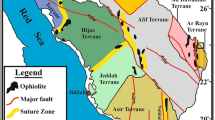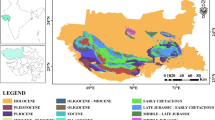Abstract
Kula Region (Manisa, Turkey), with its 80 volcanic cones, lava flows, basalt plateaus and basalt columns, fairy chimney formations in canyons carved by the Gediz River, shelter cities hidden in volcanic lava, footprint fossils belonging to the first humans, and geological uniqueness, has a great importance in terms of geotourism potential as it is being a natural heritage in the Aegean region of Anatolia. In this study, some remote sensing image processing techniques such as band combination, band rationing, and principal component analyses were used to depict the cultural and natural geosite known as Kula basalts in Turkey. Satellite images utilized here in this study were Landsat band images (band 1 to band 7). Principal component analyses (PCA) were performed on the first ratio group with 5/4, 5/1, and 3/7 bands and then on the second ratio group with 3/1, 4/5, and 3/2 bands. As a conclusion and outcome of this PCA, it was found that red, green, and blue (RGB) composite with PC1 and PC3 gray-level images from the first ratio group and PC2 gray-level image from the second group showed up the basalt areas better than those from other techniques studied in this research. After unsupervised classification of this final composite of PCA, it is computed that the basalt rocks in Kula cover an area of 36,774 ha totally.






Similar content being viewed by others
References
Abdelhamid G, Rabba I (1994) An investigation of mineralized zones revealed during geological mapping, Jabal Hamra Faddan-Wadi Araba, Jordan, using Landsat TM data. Int J Remote Sens 15(7):1495–1506
Abdelsalam MG, Stern RJ, Berhane WG (2000) Mapping gossans in arid regions with Landsat TM and SIR-C images: the Beddaho Alteration Zone in northern Eritrea. J Afr Earth Sci 30(4):903–916
Abrams MJ, Brown D, Lepley L, Sadowski R (1983) Remote sensing for porphyry copper deposits in southern Arizona. Econ Geol 78:591–604
Amer R, Kusky TM, Ghulam A (2010) Lithological mapping in the Central Eastern Desert of Egypt using ASTER data. J Afr Earth Sci 56(2–3):75–82. doi:10.1016/j.jafrearsci.2009.06.004
Assiri A, Alsaleh A, Mousa H (2008) Exploration of Hydrothermal Alteration Zones Using ASTER Imagery: A case study on Nuqrah Area, Saudi Arabia. Asian J Earth Sci 2:1819–1886
Bishta AZ, Sonbul AR, Kashghari W (2014) Utilization of supervised classification in structural and lithological mapping of Wadi Al-Marwah Area, NWArabian Shield, Saudi Arabia. Arab J Geosci 7:3855–3869. doi:10.1007/s12517-013-1044-9
Buckingham WF, Sommer SE (1983) Mineralogical characterization of rock surfaces formed by hydrothermal alteration and weathering- application to remote sensing. Econ Geol 78:664–674
Carranza EJM (2002) Geologically-Constrained Mineral Potential Mapping: Example from the Philippines. PhD Thesis, International Institute of Aerospace Survey and Earth Science (ITC)
Carranza EJM, Hale M (1999) Image processing and GIS for hydrothermal alteration mapping, Baguio district, Philippines. Proceedings of the 1999 I.E. International Geoscience and Remote Sensing Symposium, Hamburg, Germany, 28 June-2 July (on CDROM)
Chavez PS (1989) Radiometric calibration of Landsat Thematic Mapper multispectral images. Photogramm Eng Rem S 55(9):1285–1294
Chavez PS, Kwarteng AY (1989) Extracting spectral contrast in Landsat Thematic Mapper image data using selective principal components analysis. Photogramm Eng Rem S 3:339–348
Chica-Olmo M, Abarca F (2002) Development of a Decision Support System based on remote sensing and GIS techniques for gold-rich area identification in SE Spain. Int J Remote Sens 23(22):4801–4814
Crosta AP, Moore JM (1989) Enhancement of Landsat Thematic Mapper imagery for residual soil mapping in SW Minas Gerias state, Brazil: a prospecting case history in Greenstone belt terrain. Proceeding of the Ninth Thematic conference on Remote Sensing for Exploration Geology, Calgary, Alberta, Canada, 2-6 October, pp. 1173-1187
Crosta AP, De Souza Filho CR, Azevedo F, Brodie C (2003) Targeting key alteration minerals in epithermal deposits in Patagonia, Argentina, using ASTER imagery and principal component analysis. Int J Remote Sens 24:4233–4240
Darning WP (1998) Affiliated Research Center, Integrated Use of Remote Sensing and GIS for Mineral Exploration. Final Report, pp 3 – 4
Drury SA (1993) Image interpretation in Geology. Chapman and Hall, London
Drury SA, Hunt GA (1989) Geological uses of remotely-sensed reflected and emitted data of lateralized Archaean terrain in Western Australia. Int J Remote Sens 10:475–497
El Janati M, Soulaimani A, Admou H, Youbi N, Hafid A, Hefferan KP (2014) Application of ASTER remote sensing data to geological mapping of basement domains in arid regions: a case study from the Central Anti-Atlas, Iguerda inlier, Morocco. Arab J Geosci 7:2407–2422. doi:10.1007/s12517-013-0945-y
Ercan T (1984) Geology of Kula area and petrology of Kula volcanics. Ph.D Thesis, Istanbul University
Ferrier G, Griffiths KWG, Bryant R, Stefouli M (2002) The mapping of hydrothermal alteration zones on the island of Lesvos, Greece using an integrated remote sensing dataset. Int J Remote Sens 23:1–16
Gabr S, Ghulam A, Kusky T (2010) Detecting areas of high-potential gold mineralization using ASTER data. Ore Depos Rev 38:59–69
Gad S, Kusky T (2006) Lithological mapping in the Eastern Desert of Egypt, the Barramiya area, using Landsat thematic mapper (TM). J Afr Earth Sci 44:196–202
Gupta RP (2003) Remote Sensing Geology. Springer-Verlag, Berlin
Hassan SM, Ramadan TM (2014) Mapping of the late Neoproterozoic Basement rocks and detection of the gold-bearing alteration zones at Abu Marawat-Semna area, Eastern Desert, Egypt using remote sensing data. Arab J Geosci. doi:10.1007/s12517-014-1562-0
Holness MB (2005) Spatial constraints on magma chamber replenishment events from textural observations of cumulates: the Rum Layered Intrusion Scotland. J Petrol 46:1585–1601
Holness MB, Bunbury JM (2006) Insights into continental rift related magma chambers: igneous nodules from the KulaVolcanic Province, Western Turkey. J Volcanol Geoth Res 153:241–261
Hunt GR (1979) Near-infrared (1.3–2.4 µm) spectra of alteration minerals: potential for use in remote sensing. Geophysics 44:1974–1986
Jensen JR (1996) Introductory Digital Image Processing: A Remote Sensing Perspective. Prentice-Hall, New Jersey
Jing QCL, Panahi A (2006) Principal component analysis with optimum order sample correlation coefficient for image enhancement. Int J Remote Sens 27:3387–3401
Kaufmann H (1988) Mineral exploration along the Agaba-Levant structure by use of TM-data concepts, processing and results. Int J Remote Sens 9:1630–1658
Kusky TM, Ramadan TM (2002) Structural controls on Neoproterozoic mineralization in the South Eastern Desert, Egypt: an integrated field, Landsat TM, and SIR-C/X SAR approach. J Afr Earth Sci 35:107–121
Liu F, Wu X, Sun H, Guo Y (2007) Alteration information extraction by applying synthesis processing techniques to Landsat ETM + data: case study of Zhaoyuan Gold Mines, Shandong Province, China. J China Univ Geosci 18:72–76
Loughlin WP (1991) Principle components analysis for alteration mapping. Photogramm Eng Rem S 57:1163–1169
Madani A, Bishta A (2002) Selection of the optimum bands of Landsat-7 ETM + for automatic lineaments extraction: a case study of Qattar Granites, North Eastern Desert, Egypt. 6th International Conference on the Geology of the Arab World, 6. Cairo University, pp. 353–360
Madani A, Abdel Rahman EM, Fawzy KM, Emam A (2003) Mapping of the hydrothermal alteration zones at Haimur Gold Mine Area, South Eastern Desert, Egypt using remote sensing techniques. Egypt J Remote Sens Space Sci 6:47–60
Madani A, Harbi H, Eldougdoug A (2008) Utilization of remote sensing techniques for mapping the listwaenite associated with Jabal Al-Wask Ophiolite Complex, Northwestern Saudi Arabia. Egypt J Remote Sens Space Sci 11:57–72
Moore CA, Hoffmann GA, Glenn NA (2007) Quantifying basaltic rock outcrops in NRCS Soil Map Units Using Landsat-5 Data. Soil Surv Horiz 48:59–63
Pournamdari M, Hashim M (2014) Detection of chromite bearing mineralized zones in Abdasht ophiolite complex using ASTER and ETM+ remote sensing data. Arab J Geosci 7:1973–1983. doi:10.1007/s12517-013-0927-0
Qari MHT (2011) Utilizing image processing techniques in lithologic discrimination of Buwatah area, Western Arabian Shield. Arab J Geosci 4:13–24. doi:10.1007/s12517-009-0049-x
Raines GL, Offield TW, Santos ES (1978) Remote sensing and subsurface definition of facies and structure related to uranium deposits Powder River Basin. Wyoming Econ Geol 75:1706–1725
Rajesh HM (2008) Mapping Proterozoic unconformity related uranium deposits in the Rockhole area, Northern Territory, Australia using landsat ETM+. Ore Geol Rev 33:382–396
Ramadan TM, Kontny A (2004) Mineralogical and structural characterization of alteration zones detected by orbital remote sensing at Shalatein District, SE Desert, Egypt. J Afr Earth Sci 40:89–99
Ramadan TM, Abdelsalam MG, Stern RJ (2001) Mapping gold-bearing massive sulfide deposits in the Neoproterozoic Allaqi Suture, Southeast Egypt with Landsat TM and SIR-C/X SAR images. Photogramm Eng Rem S 67(4):491–497
Ranjbar H, Honarmand M, Moezifar Z (2004) Application of the Crosta technique for porphyry copper alteration mapping, using ETM data in the southern part of the Iranian volcanic sedimentary belt. J Asian Earth Sci 24:237–243
Rawashdeh SA, Saleh B, Hamzah M (2006) The use of remote sensing technology in geological investigation and mineral detection in El Azraq-Jordan. Cyber Geo 12(11):1–22
Richardson-Bunbury JM (1996) The Kula Volcanic Field, Western Turkey: the development of a Holocene alkali basalt province and the adjacent normal faulting graben. Geol Mag 133:275–283
Rokos D, Argialas D, Mavrantza R, St.-Seymour K, Vamvoukakis C, Kouli M, Lamera S, Paraskevas H, Karfakis I, Denes G (2000) Structural mapping and analysis for a preliminary investigation of possible gold mineralization by using remote sensing and geochemical techniques in a GIS environment: study area: island of Lesvos, Aegean Sea, Hellas. Nat Resour Res 9:277–293
Rothery DA (1987) Improved discrimination of rock units using Landsat Thematic Mapper imagery of the Oman ophiolite. J Geol Soc London 144:587–597
Rowan LC, Bowers TL (1995) Analysis of linear features mapped in Landsat thematic mapper and side-looking airborne radar images of the Reno, Nevada 18 by 28 quadrangle, Nevada and California - implications for mineral resource studies. Photogramm Eng Rem S 61:749–759
Rowan LC, Wetlaufer PH, Goetz AFH, Billingsley FC, Stewart JH (1977) Discrimination of rock types and detection of hydrothermally altered areas in south-central Nevada by use of computer-enhanced ERT images. US Geological Survey Professional Paper 883
Ruiz-Armenta JR, Prol-Ledesma RM (1998) Techniques for enhancing the spectral response of hydrothermal alteration minerals in Thematic Mapper images of Central Mexico. Int J Remote Sens 19(10):1981–2000
Sabins FF (1999) Remote sensing for mineral exploration. Ore Geol Rev 14(3-4):157–183
Salem SM, Soliman NM, Ramadan TM, Greiling RO (2014) Exploration of new gold occurrences in the alteration zones at the Barramiya District, Central Eastern Desert of Egypt using ASTER data and geological studies. Arab J Geosci 7:1717–1731. doi:10.1007/s12517-013-0874-9
Sultan M, Arvidson RE (1986) Mapping of serpentinites in the Eastern Desert of Egypt by using Landsat Thematic Mapper data. J Geol 14(12):995–999
Tangestani MH, Moore F (2002) Porphyry copper alteration mapping at the Meiduk area, Iran. Int J Remote Sens 23(22):4815–4825
Tokcaer M, Agostini S, Savascin MY (2005) Geotectonic Setting and Origin of the Youngest Kula Volcanics (Western Anatolia), with a New Emplacement Model. Turkish J Earth Sci 14:145–166
Vincent RK (1997) Fundamentals of Geological and Environmental Remote Sensing. Prentice Hall, New Jersey
Warner NH, Farmer JD (2008) Laboratory and Remote Identification of Hydrothermal Alteration Materials Associated with Subglacial Outflood Surfaces in Iceland. Lunar and Planetary Science, p. 1477
Yazdi M, Sadati N, Matkan AA, Ashoorloo D (2011) Application of Remote Sensing in Monitoring of Faults. Int J Environ Res 5(2):457–468
Youssef AM, Hassan AM, El Moneim Mohamed MA (2009) Integration of remote sensing data with the field and laboratory investigation for lithological mapping of granitic phases: Kadabora pluton, Eastern Desert, Egypt. Arab J Geosci 2:69–82. doi:10.1007/s12517-008-0020-2
Acknowledgments
The authors thank Professor Abdullah M. Al-Amri for his editorial handling of the manuscript and the anonymous referees for their detailed and constructive reviews. Satellite images of this study were processed in Image Processing Laboratory of the Geomatics Department of Gumushane University.
Author information
Authors and Affiliations
Corresponding author
Rights and permissions
About this article
Cite this article
Corumluoglu, O., Vural, A. & Asri, I. Determination of Kula basalts (geosite) in Turkey using remote sensing techniques. Arab J Geosci 8, 10105–10117 (2015). https://doi.org/10.1007/s12517-015-1914-4
Received:
Accepted:
Published:
Issue Date:
DOI: https://doi.org/10.1007/s12517-015-1914-4




